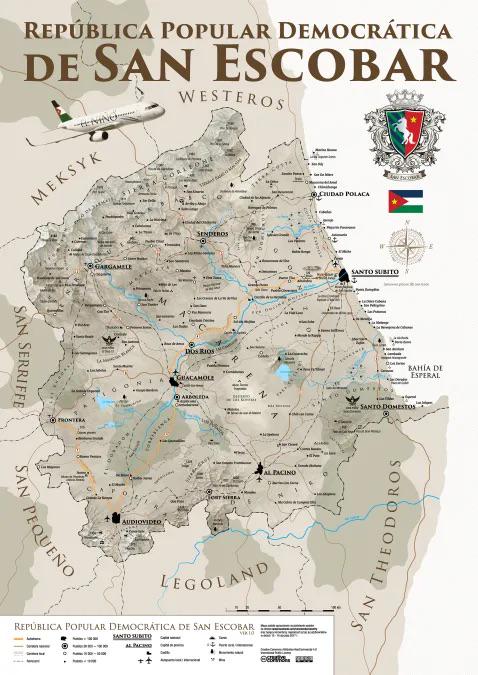Map of the Fictional Country San Escobar


David Chen
Data Visualization Specialist
David Chen is an expert in transforming complex geographic datasets into compelling visual narratives. He combines his background in computer science ...
Geographic Analysis
What This Map Shows\nThis map depicts the fictional country of San Escobar, a whimsical creation that emerged from a slip of the tongue by Poland's foreign minister in January 2017. Intended to reference the real Caribbean nation of Saint Kitts and Nevis, the minister mistakenly introduced San Escobar to the world. Almost instantly, this fictional nation captured the imagination of internet users, leading to the creation of maps, flags, and even travel guides that humorously detailed life in this non-existent country. The map serves not only as a visualization of this unique phenomenon but also highlights the power of social media and the internet in shaping narratives and generating interest around fictional places.
Deep Dive into Fictional Geography\nInterestingly, the concept of fictional geography is not new. It has existed for centuries, with authors, artists, and creators developing entire worlds that serve as settings for their stories. In this particular case, San Escobar stands out because it came into existence due to a public gaffe rather than a deliberate artistic endeavor. But what makes a fictional country resonate so strongly with people?
Fictional places often serve as a canvas for creativity, allowing individuals to explore ideas that might not be possible in the real world. San Escobar became a symbol of humor and a light-hearted commentary on international diplomacy. This phenomenon showcases how a few words can spark a wave of creativity, leading to the development of maps that illustrate imagined borders, capitals, and even cultural elements.
The map of San Escobar features an array of playful elements that reflect the whimsy of its inception. For instance, one might imagine a tropical climate with lush vegetation, vibrant beaches, and a laid-back lifestyle, drawing on the characteristics commonly associated with Caribbean nations. The fictional country might boast its own unique culture, cuisine, and even a language, further enriching its narrative.
Moreover, the creation of San Escobar allows us to consider the implications of geography in the modern digital age. The rapid sharing of information and the blending of reality with fiction highlight how global connectivity can lead to the formation of new ideas and cultural narratives. In a world filled with political tension and serious discussions, San Escobar serves as a reminder that humor and creativity can also play a role in international relations.
Regional Analysis\nExamining the fictional geography of San Escobar allows us to draw comparisons with real Caribbean nations. For example, just as Saint Kitts and Nevis is known for its tourism and picturesque landscapes, San Escobar could be imagined as a travel hotspot, appealing to those seeking relaxation and adventure. The map might also suggest that San Escobar shares cultural traits with its real-world counterparts, such as vibrant music, lively festivals, and unique culinary traditions.
Interestingly, if we were to break down the imagined demographics of San Escobar, we might envision a diverse population with influences from various cultures, reflecting the melting pot that is typical of the Caribbean region. The fictional country could be portrayed as a haven for artists, musicians, and craftsmen, emphasizing creativity and community spirit.
Significance and Impact\nThe story of San Escobar is significant not only as a humorous anecdote but also as a reflection of how culture and geography intersect in the age of the internet. It raises questions about the nature of national identity and how fictional narratives can influence real-world perspectives. In a time when misinformation can spread rapidly, the popularity of a fictional country like San Escobar provides an interesting case study in how people engage with geography and national identity in a playful manner.
As we look to the future, the legacy of San Escobar might prompt discussions about the role of fiction in shaping our understanding of geography. It invites us to ponder: how do fictional places influence real-world tourism, culture, and even diplomacy? By embracing the light-hearted nature of San Escobar, we open the door to a world where creativity and geography can coexist, leading to new forms of storytelling and exploration.
In conclusion, the map of San Escobar is more than just a playful representation of a fictional country; it embodies the spirit of creativity and the interconnectedness of our digital age. It encourages us to embrace imagination while also recognizing the real-world implications of our narratives.
Visualization Details
- Published
- September 13, 2025
- Views
- 98
Comments
Loading comments...